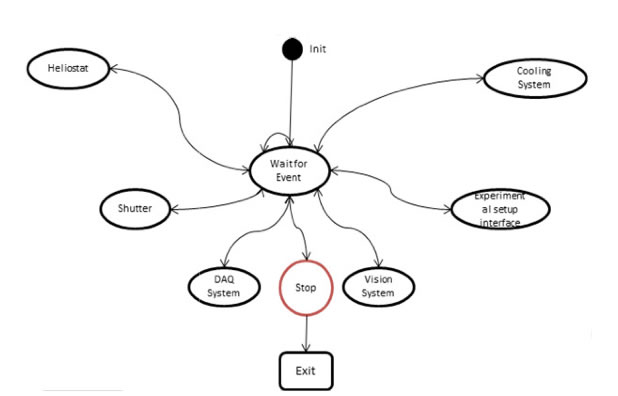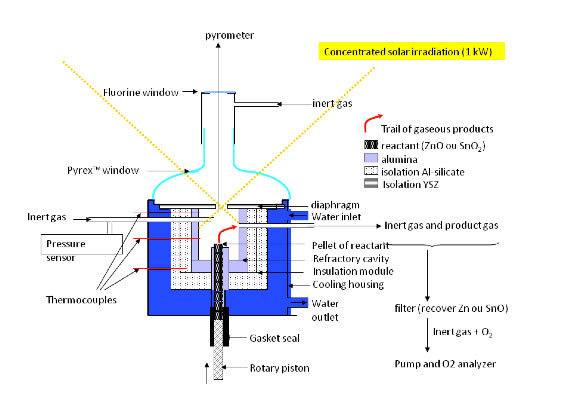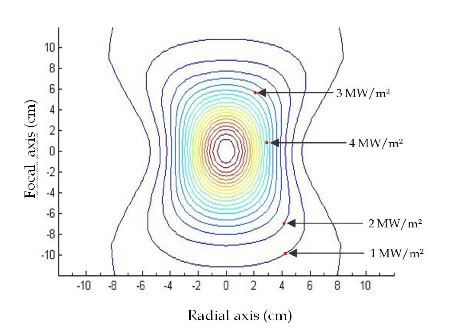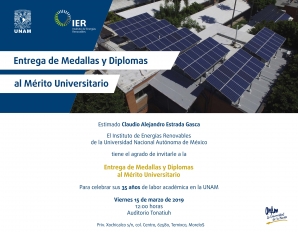Super User
Abstract
This paper presents the control system design of a new high flux solar furnace that is being developed in Mexico at the Center for Energy Research of the National University of Mexico. The control of the whole system is critical for the correct operation of it. The control system consists of a rugged PC running state machine-based software which manages the operation of all the user interfaces for the furnace systems which are the heliostat, shutter, cooling, visual and data acquisition subsystems, as well as the positioning desk control. The control routines run in real-time controllers dedicated for each subsystem. The computer routines used by the main program and the tests made for characterizing the heliostat follow-up system is also described. Preliminary results obtained shows that the heliostat control presents great versatility due to the type of control it has, including the possibility of accepting feedback through images projected by it.
C.A. Pérez-Rábago, R. Guzmán-Galán, N. Flores-Guzmán, E. Brito, D. Marroqui-García, R. Pérez-Enciso, D. Riveros-Rosas, C.A. Arancibia-Bulnes, C.A. Estrada
Control System for the High-Flux Solar Furnace of CIE-UNAM in Temixco, Mexico. First Stage

Abstract
A new facility known as Heliostat Test Field has been developed in Mexico. It consists of a solar tower, a laboratory, and 16 heliostats. Three different optical tests have been implemented for the evaluation of heliostats at this installation: sun tracking test, reflected spot test, and deflectometry test. These tests allow the evaluation of tracking, and slope errors of the heliostats. In particular, the later provides detailed slope maps of the reflecting mirrors
Heliostat Testing at a New Facility in Sonora, Mexico
Camilo A. Arancibia-Bulne s, Manuel I. Peña-Cruz, David Marroquín-García, Rafael E. Cabanillas, Carlos A. Pérez-Rábago, David Riveros-Rosas, Jesús F. Hinojosa and Claudio A. Estrada

Abstract
Due to water pollution at urban as well as industrial and rural level, there exists the need to introduce and improve new alternative technologies to traditional methods for waste water treatment. It is important that new technologies must be economic, effective and environment friendly. The above mentioned alternative technologies are in this case the heterogeneous photocatalysis with TiO2 and photo-Fenton processes which use the solar radiation as exciting source to produce species highly oxidative that can degrade the organic matter present in polluted water. This paper describes the construction of a Photocatalytic Solar Plant located at the installations of the Energy Research Center of the National University of Mexico (CIE-UNAM), which is composed by different photocatalytic reactor integrated with CPC solar concentrators whose concentration varies between 1 and 2 suns. The photoreactors and equipped with temperature, pH, COD and DO online sensors. Moreover, the plant counts with an analytical laboratory equipped with a Total Organic Carbon(TOC) analyzer and a UV-VIS spectrophotometer. In addition, immobilized TiO2 photocatalysts on glass pipes Pyrex® were prepared, which lately were introduced into the photocatalytic reactor. The catalyst immobilization on glass pipes eliminates in an effective way the recovery process of powder photocatalysts, and also saves time and work costs. The technical feasibility and performance of the photocatalytic degradation of the plaguicide carbaryl at pilot level have been here studied.
Ivan SalgadoTránsito, Antonio E. Jiménez González, Claudio A. Estrada Gasca, Camilo Arancibia Bulnes, Rogelio Morán Elvira, Carlos Antonio Pineda Arellano, Eduardo Iragorri, Cesar Pérez Franco and Emmanuel Hernández Martínez

Abstract
The high-temperature solar processes are one of the promising alternatives to carry out materials transformations for chemical industry, like the calcinations of calcium carbonate for solar production of lime or cement, production of activated charcoal, etc. The production of energy carriers, such as the hydrogen, is a preponderant application that is focused on hydrocarbons substitution, along with very low or null greenhouse gas emissions. This method has the advantage of producing long-term storable and transportable energy carriers from solar energy. The thermochemical hydrogen production through water splitting is one of the most promising routes to obtain “solar hydrogen”.
H.I. Villafán Vidales, S. Abanades, H. Romero-Paredes, C.A. Estrada and C.A. Arancibia-Bulnes

Abstract
This paper discusses the methods implemented for the solution of the drift and backslash problems in the heliostat of the High Radiative Flux Solar Furnace recently built at the Center for Energy Research of the Universidad Nacional Autónoma de México, located at the geographical coordinates 18° 50' 24" North and 99° 15' 00" West. To solve the observed drift, various algorithms were analyzed for the calculation of the solar vector,and a closed loop through an electronic device was implemented which makes corrections to the position of the heliostat. Drift was corrected by means of unbalancing the heliostat.
R. Pérez-Enciso, E. Brito-Bazan, C. A. Arancibia-Bulnes, D. Riveros-Rosas, C. A. Perez-Rábago, J.J.Quiñones, C. A. Estrada
Correction of the Concentrated Sunlight Spot’ s Drift of the CIE-UNAM Solar Furnace

Abstract
Atrazine, a herbicide commonly used around the world and listed by the European Union and by the US EPA as one of the priority pollutants, was subjected to photocatalytic degradation processes at pilot level on a solar photocatalytic plant located in Temixco, Morelos, Mexico. The photocatalytic reactor used for the degradation of the herbicide atrazine by photo-Fenton processes, is equipped with an online monitoring system of the main variables that characterize the reaction (COD, TOC, DO, pH and T). Atrazine, as a toxic compound, was degraded photocatalytically in more than 90% in a relatively short time (340 min) of exposure to solar radiation, reaching a level of mineralization (TOC) of 60% and a decrease of COD of more 50%. Toxicity tests of the contaminated solution were also conducted at the beginning and end of treatment with Artemia Franciscan Kellogg, finding that such toxicity was reduced by over 90%.
Antonio E. Jiménez-González, Carlos Antonio Pineda-Arellano, Cesar Pérez-Franco, Eduardo Iragorri-Sámano, Ana Gabriela Gutierrez-Mata e Ivan Salgado Tránsito.
Abstract
Since August 2011, the 30 kWt Solar Furnace for Higher Radiative Fluxes (HoSIER) of the Renewable Energy Institute (former Center for Energy Research) of the National University of Mexico (IER-UNAM) is in operation. The optical design of the HoSIER-UNAM includes a total of 409 spherical facets, divided into 5 different focal length groups [1]. A ray-tracing simulation was carried out to realize a three-dimensional analysis of the concentrated solar radiation distribution at the focal area of the HoSIER. In this way, theoretical profiles of the radiative flux were obtained. To get the experimental profiles of the concentrated solar irradiance of the HoSIER, a Lambertian screen was placed in the focal zone, normal to the optical axis of the concentrator. The screen was movedalong 10 cm on the focus with each flat separated 5 mm of distance and in front of a CCD 8-bit digital camera. With the CCD was possible to obtain several experimental radiative flux distributions and thus it was possible to validate the ray-tracing simulation. This comparison shows a very good agreement between experimental and theoretical distribution.
R. Perez-Enciso, D. Riveros-Rosas, M. Sanchez, C.A. Pérez-Rabago, C.A. Arancibia-Bulnes, H. Romero-Paredes, C.A. Estrada

H. I Villafán-Vidales, A. Bautista-Orozco, A. Jiménez-González, C.A. Estrada
L. A. Díaz-Félix, M. Escobar-Toledo, J. Waissman, N. Pitalúa-Díaz, C. A. Arancibia-Bulnes
C. Iriarte-Cornejo, C. A. Arancibia-Bulnes, J. Waissman, R. E. Cabanillas, C. A. Estrada

